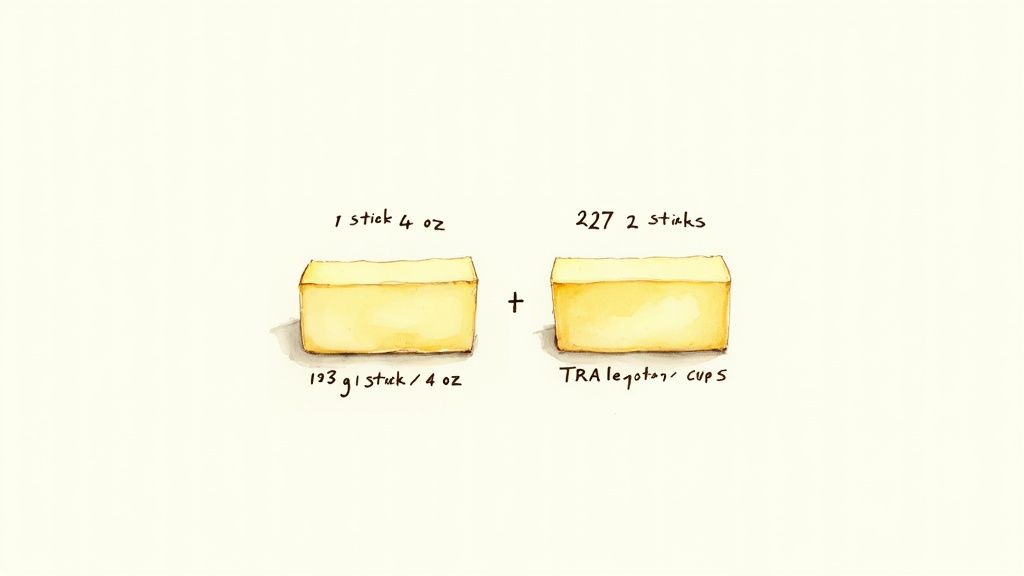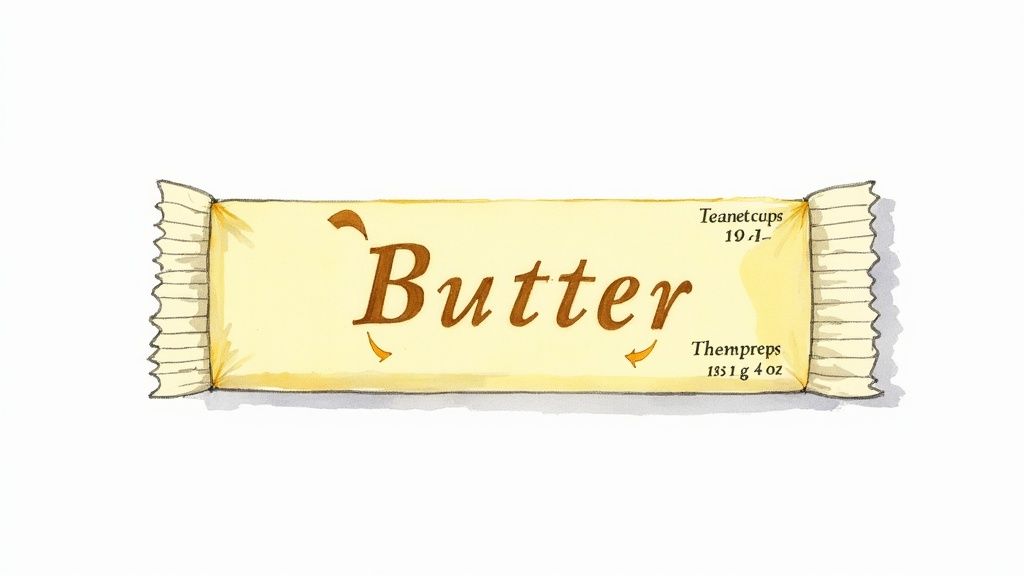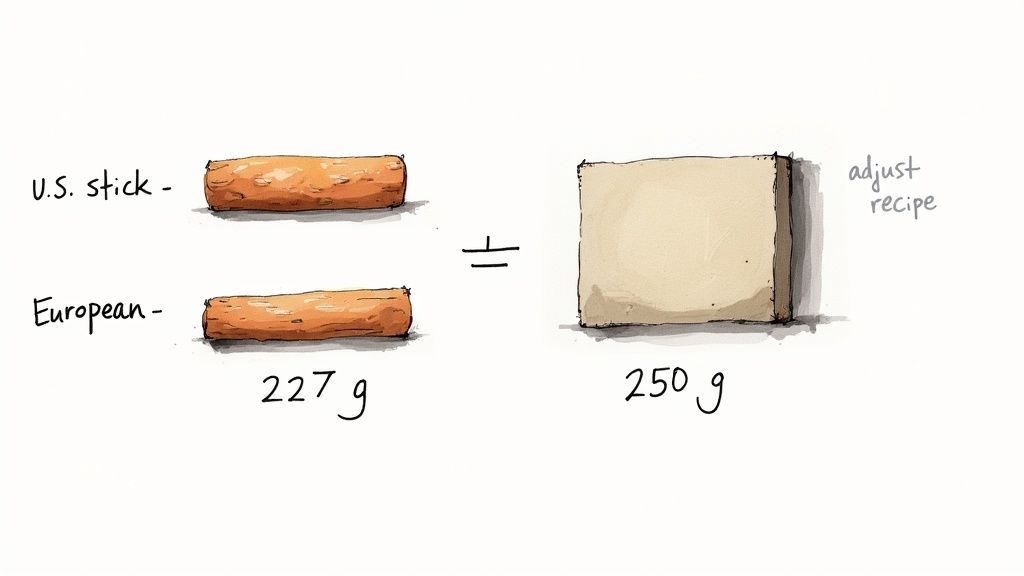If you’ve ever found yourself pausing mid-recipe, wondering exactly how much two sticks of butter weigh in grams, you’re not alone. Here’s the straight answer you need for perfect baking.
Two standard U.S. sticks of butter weigh 227 grams.
It’s a simple but crucial conversion. Since a single stick is 113 grams, the math is easy to scale up or down depending on what you're making.
Your Quick Guide to Butter Conversions
Getting butter measurements right can feel confusing, especially when recipes jump between sticks, grams, cups, and tablespoons. The good news is that in the U.S., a stick of butter is a standardized unit.
One stick of butter is always 113 grams, which also equals 1/2 cup, 4 ounces, or 8 tablespoons. So, when that cookie recipe calls for two sticks, you know you need 227 grams or one full cup. This reliability is why the stick has become such a handy kitchen staple.

To make things even easier, I've put together a simple reference table. It's designed to help you quickly see how different amounts of butter translate across all the common units of measurement. No more guesswork—just confident baking.
Quick Butter Conversion Reference Table
This table is your go-to for the most common butter amounts you'll encounter in recipes.
| Sticks of Butter | Grams (g) | Cups | Ounces (oz) | Tablespoons (TBSP) |
|---|---|---|---|---|
| 1/2 Stick | 57g | 1/4 Cup | 2 oz | 4 TBSP |
| 1 Stick | 113g | 1/2 Cup | 4 oz | 8 TBSP |
| 2 Sticks | 227g | 1 Cup | 8 oz | 16 TBSP |
| 4 Sticks | 454g | 2 Cups | 16 oz | 32 TBSP |
Keep this chart handy, and you'll never have to second-guess your measurements again. For more detailed conversions covering other common baking ingredients, be sure to check out our complete guide for converting cups to grams.
Cracking the Code of the US Butter Stick
Ever find yourself staring at a recipe from the US and wondering what exactly a "stick" of butter is? It’s a classic American kitchen staple, and for good reason. The standard US stick of butter weighs a very specific 113 grams. That's also equal to 4 ounces, or a neat ½ cup.
This pre-measured format became the gold standard in American homes because it made baking so much simpler. Instead of getting out a scale, you could just grab a stick. This is why so many recipes are written this way—it takes the guesswork out and helps everyone get consistent results.

Let the Wrapper Be Your Guide
One of the handiest things about American butter is the wrapper itself. It’s not just packaging; it's a measuring tool printed with handy guides.
- Tablespoon Markings: You'll see lines for each tablespoon. Since a full stick has 8 tablespoons, you can just slice off what you need with confidence.
- Cup Measurements: The wrapper also usually marks off common cup fractions, like ¼ cup (which is half the stick) or even ⅓ cup.
So, if a recipe calls for 4 tablespoons of butter, you can just find the "4 TBSP" line and cut right there. This clever design is what connects a weight measurement (113 grams) to a volume measurement (½ cup). It's the key to knowing that when a recipe asks for two sticks of butter, it's really asking for a precise 227 grams.
Butter Measurements Around the World
Ever grab a recipe from a cookbook or a blog based in another country and find yourself scratching your head over the butter measurements? It’s a common problem. What seems straightforward in one kitchen can quickly become a conversion puzzle in another, but figuring out these differences is the secret to getting international recipes just right.
In the United States, we're used to the handy "stick" system. Two sticks of butter are a neat and tidy 227 grams. This isn't the standard everywhere, though. Getting a handle on the different systems is crucial for baking accuracy, no matter where the recipe comes from.

US Sticks vs. Metric Blocks
While butter sticks are dominant in the U.S. and Canada, the rest of the world often does things differently. In Australia and across much of Europe, you’ll typically find butter sold in solid metric blocks, usually weighing 250 grams or 200 grams.
This is where bakers can get into trouble. A 250g block of European butter, for instance, contains just a bit more than two U.S. sticks (227g). That 23-gram difference might not sound like a lot, but for delicate baked goods like pastries or finicky cakes, it can be enough to throw off the texture.
When you're substituting, precision is key. If your American recipe calls for two sticks of butter (227g) but all you have is a 250g block, just slice off about 1.5 tablespoons (which is roughly 23g) before you start mixing.
That simple trim keeps the recipe's crucial fat-to-flour ratio exactly as the author intended. If you need more help with these kinds of kitchen conversions, our guide on converting grams to cups is a great resource for all sorts of ingredients.
Your Go-To Butter Conversion Chart

Think of this chart as your ultimate kitchen cheat sheet for any butter measurement you could possibly need. Whether you're whipping up a delicate pastry or just trying out a new recipe, keeping these conversions handy will save you a ton of time and help you avoid those common baking blunders.
We've covered everything from a single tablespoon all the way up to a full pound of butter. So, when a recipe calls for two sticks of butter, you'll know instantly that you need 227 grams, which is also the same as one cup or 16 tablespoons. It’s designed to be your quick-glance guide, taking the guesswork out of your cooking.
Detailed Butter Measurement Conversion Chart
Here’s a more detailed breakdown to help make your cooking and baking as precise as possible. I suggest bookmarking this page—it's a real lifesaver when you're halfway through a recipe.
| Measurement | Grams (g) | Ounces (oz) | Cups | Tablespoons (TBSP) |
|---|---|---|---|---|
| ¼ Stick | 28g | 1 oz | ⅛ Cup | 2 TBSP |
| ½ Stick | 57g | 2 oz | ¼ Cup | 4 TBSP |
| 1 Stick | 113g | 4 oz | ½ Cup | 8 TBSP |
| 1 ½ Sticks | 170g | 6 oz | ¾ Cup | 12 TBSP |
| 2 Sticks | 227g | 8 oz | 1 Cup | 16 TBSP |
| 4 Sticks (1 lb) | 454g | 16 oz | 2 Cups | 32 TBSP |
Having a solid chart like this is incredibly useful, but it's really just the beginning. If you need even more kitchen help, you can explore other fantastic online tools for everyday recipes that make any conversion a breeze.
If you've ever wondered why your cookies came out great one time and fell flat the next, the answer might be in how you measured your butter. In the world of baking, measuring by weight (like grams) is always going to beat measuring by volume (like cups).
There's a good reason professional bakers live by their kitchen scales: it's all about precision. Grams measure mass, which is a constant. A cup, on the other hand, measures volume, which can change dramatically depending on the ingredient's state.
Let’s take our two sticks of butter, which we know is exactly 227 grams. If you try to measure one cup of butter, the amount you actually get can vary. A cup of cold, hard butter packed into a measuring cup will have a different weight than a cup of light, whipped, or softened butter. That's where things go wrong.
Why It Matters for Your Baking
Baking is basically chemistry. The ratio of fat to flour, sugar, and liquids is what creates the perfect texture. Throwing that ratio off, even by a little, can have a big impact.
- Too much butter: Your cookies might spread into thin, greasy wafers.
- Too little butter: You could end up with a cake that's dry and crumbly or pastries that are tough instead of flaky.
When a recipe calls for two sticks of butter, measuring out 227 grams on a scale takes all the guesswork out of the equation. You're using the exact amount of fat the recipe creator intended, which is the secret to getting consistent, delicious results every single time. Making this one small change is one of the fastest ways to level up your baking skills.
The consistency you gain from weighing ingredients is undeniable. It ensures that your butter-to-flour ratio is perfect, which is the foundation for achieving the ideal texture in everything from flaky pie crusts to chewy brownies.
Once you start appreciating the precision that weighing ingredients brings to your baking, you might get inspired to try new things. You can always explore food ideas and find new recipes to put your new skills to the test. Trust me, making the switch will give you so much more control and confidence in the kitchen.
How to Measure Butter Without a Scale
While a digital scale is every serious baker's best friend for precision, you can still get perfectly accurate butter measurements without one. You just need a couple of simple tricks using tools you already own.
The most straightforward way is to rely on the markings printed right on the butter wrapper. In the U.S., a standard stick of butter has lines marking out each tablespoon. Since one stick is eight tablespoons, you can just slice off what you need by following the guide.
Using the Water Displacement Method
But what if you have an odd-shaped chunk of butter, or you've already thrown the wrapper away? This is where the water displacement method comes in handy. It’s a brilliant little science trick that works like a charm in the kitchen.
Here's how it's done:
- Start by pouring one cup of cold water into a liquid measuring cup.
- Gently add your piece of butter, making sure it's completely submerged.
- Watch the water level rise. The amount it rises is the exact volume of your butter.
So, if the water level goes from one cup up to the 1 ½ cup line, you've got exactly ½ cup of butter. That's the equivalent of one stick or 113 grams. It’s a foolproof technique for getting it right every single time.
For more smart kitchen solutions, see how you can cook with ingredients you already have in your pantry.
Common Butter Conversion Questions Answered
When you're deep in a recipe, the last thing you want to do is stop and wrestle with confusing measurements. Here are some quick, clear answers to the most common butter questions that pop up in the kitchen.
Can I Measure Butter After It's Melted?
This is a classic kitchen conundrum. While one cup of solid butter and one cup of melted butter both weigh the same (227 grams), their volumes are not interchangeable. Why? Solid butter has air whipped into it, making it take up more space.
The key is to follow the recipe's wording precisely. If it calls for a "cup of melted butter," go ahead and melt it first, then measure it out. If it simply asks for "one cup of butter," measure it while it's solid and then melt it if needed.
Does Salted vs. Unsalted Butter Weigh Differently?
Nope, the weight is exactly the same. A stick of salted butter weighs 113 grams, just like its unsalted counterpart.
The only real difference is the salt content, which is a good thing to keep in mind so you can adjust the other salt in your recipe. If you're keeping an eye on nutritional details, you can see how small ingredient changes affect a dish with a good recipe calorie calculator.

